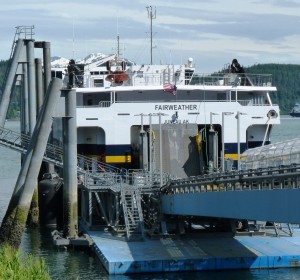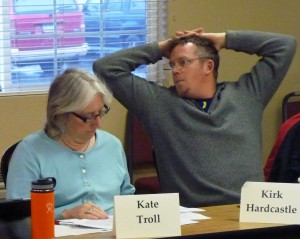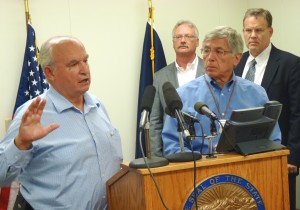
Three ferries dock at the Ketchikan Shipyard for repairs and upgrades in 2012. Four of the 11-vessel fleet could tie up under a draft budget plan. (Ed Schoenfeld/CoastAlaska News)
The year 2015 saw the beginnings of major changes to the Alaska Marine Highway, the Tongass National Forest and the possible future of transboundary mines.
Ferry service cuts
The year began with plans to sail 11 ferries on a full schedule, from Bellingham, Washington, to Dutch Harbor/Unalaska, in the Aleutian Islands. It ends with four fewer ships and long gaps between stops at some small port cities.

The fast ferry Fairweather docks at Juneau’s Auke Bay ferry terminal. It and its sister ship have been tied up for the fall and winter. (Photo by Ed Schoenfeld/CoastAlaska News)
The state House and Senate passed operating budgets calling for drastic reductions in the face of declining oil revenues. Leaders from Railbelt communities questioned the system’s cost and value to commerce and travel.
The marine highway dodged a bullet at the end of the legislative session, when a last-minute compromise removed the deepest cuts, allowing the system to maintain most of its published summer schedule.
But that was a temporary fix. Fewer ships are sailing this winter, and deeper cuts will come in the summer.
Officials announced in June that they planned to tie up the fast ferries Chenega and Fairweather, as well as the mainliner Taku. A draft schedule released in October also put the Malaspina out of service during the fiscal year beginning in July. The final version, due out in January, may include some sailings from one of the fast ferries.
The schedule reflects cuts proposed by Gov. Bill Walker in his operating budget plan. The Legislature may make further cuts.
Tongass timber transition
The U.S. Forest Service developed plans to transition Southeast’s logging industry from old- to younger-growth harvests in 2015.

Conservation representative Kirk Hardcastle listens while Juneau Assemblymember Kate Troll reviews a report during a Tongass Advisory Committee meeting Feb. 17 in Juneau. (Photo by Ed Schoenfeld/CoastAlaska News)
An advisory committee of business, tourism, Native and conservation leaders that began in 2014 continued meeting to draft recommendations on the transition. It wrapped up its work in May and some, but not all, of its suggestions were incorporated into an updated Tongass land management plan.
That plan, released in November, calls for a 16-year transition to mostly young-growth logging.
Meanwhile, the Forest Service continued planning and scheduling timber sales.
The Big Thorne sale on Prince of Wales Island, one of the largest in years, made it past a court challenge in March. But a smaller Mitkof Island sale approved the same month was withdrawn in November in the face of legal challenges.
The Tongass also saw a change in its top leadership in 2015. Longtime Forest Supervisor Forrest Cole stepped down in April after 40 years with the Forest Service. He was replaced in May by Earl Stewart, who previously worked at Arizona’s Coconino National Forest.
Transboundary mining
Southeast Alaska also saw growing concerns in 2015 about transboundary mining.
British Columbia’s Red Chris project in the Stikine River watershed began full operations over the summer. A smaller mine, Brucejack, won permits needed to move toward construction and production.

B.C. Mines Minister Bill Bennett discusses transboundary mining as Lt. Gov. Byron Mallott listens during an Aug. 26 press conference. (Photo by Ed Schoenfeld/CoastAlaska News).
Lt. Gov. Byron Mallott started an internal state working group to study mine growth and its potential to damage salmon-rich rivers flowing from near mines into Southeast Alaska in February. He traveled to British Columbia in May to press the state’s concerns. And Bill Bennett, the province’s top mining official, visited Southeast in September.
As the year neared its end, the two governments signed an agreement to work together to address mine safety and pollution threats.
Critics, including tribal, fisheries and tourism leaders, said it lacked teeth. But Mallott said the state could only go so far.
Mining opponents continue to call for federal involvement that could strengthen Alaska’s options by sending the issue to the International Joint Commission, which takes on transboundary water disputes.
































